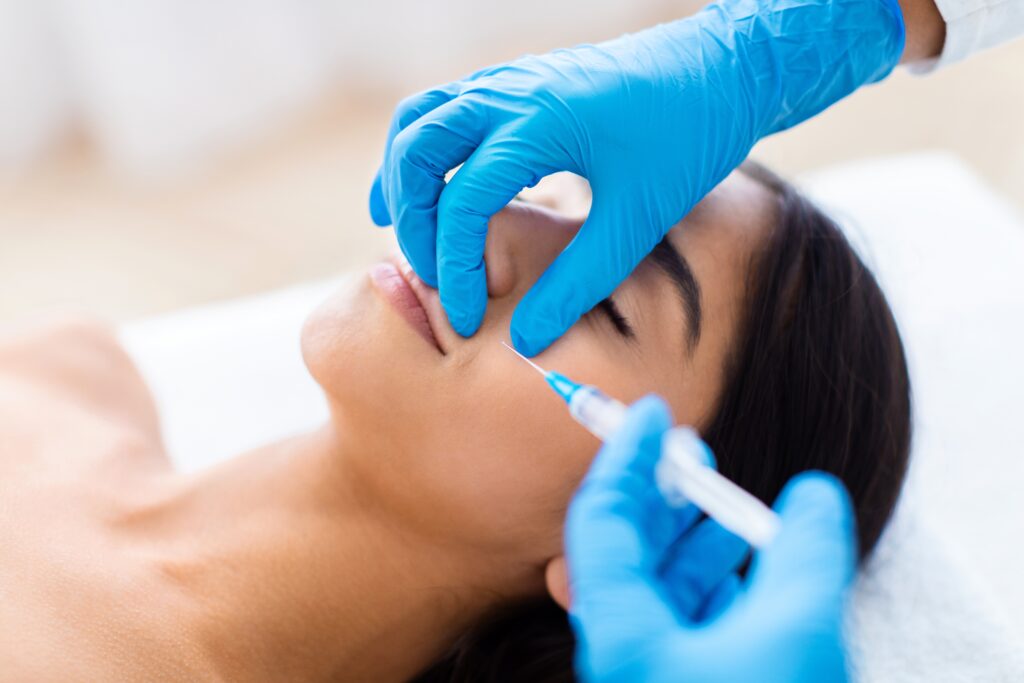
Trichloroacetic acid (TCA) chemical peels are among the most popular non-surgical, noninvasive medical cosmetic procedures for addressing many common skin concerns such as acne scars, hyperpigmentation, and uneven skin tone. In addition, higher concentration TCA chemical peels may also help reduce the appearance of fine lines and wrinkles.
Because of the variety of concerns that a TCA chemical peel can address as well as the simplicity of the procedure, it is an option that often appeals to patients. However, there are various considerations that patients need to discuss with their medical practitioners before committing to a chemical peel. Let’s take a look at how TCA peels work, who they benefit, and what to expect from the procedure.
Understanding TCA Chemical Peels
A TCA peel is essentially an exfoliation process; however, unlike the gentle exfoliants many people use at home, TCA peels use stronger, medical-grade ingredients to chemically exfoliate the skin for more significant results. Chemical peels come in a range of strengths, defined by the concentration of TCA in them and how far they penetrate below the surface layer of the skin. At The Rejuva Center, we offer three different strengths of TCA chemical peels: light, medium, and deep. Let’s take a look at the differences between these options before diving into the benefits.
Light TCA Chemical Peels
As the name implies, light chemical peels are the gentlest option. At The Rejuva Center, this means they contain 10% or less TCA solution. Light chemical peels help brighten skin and address minor pigmentation or acne issues. Since the treatments are light, patients will recover from a light chemical peel more quickly than the other depths, and they require little to no downtime following the procedure.
Medium TCA Chemical Peels
Medium-depth chemical peels contain between 10% to 15% TCA concentration at The Rejuva Center. Because they penetrate to a deeper degree, medium-depth TCA peels can help patients address more significant skin issues, including minimizing fine lines and wrinkles, enhancing elasticity, and increasing collagen production.
Medium-depth TCA chemical peels also help address deeper acne scars and more serious hyperpigmentation. However, because the treatments are more intense, the recovery time for medium-depth chemical peels may be a few days longer than light chemical peels and skin flaking — the most common chemical peel side effect — may be more noticeable.
Deep TCA Chemical Peels
Finally, patients may opt for a deep chemical peel if they need more aggressive treatment for conditions like deep acne scars (or a high concentration of them), sun damage, and deep wrinkles. At The Rejuva Center, we offer deep chemical peels that contain between 15-20% concentration of TCA. Deep chemical peels come with greater risks and longer recovery times. Patients often experience redness and facial peeling that can last more than a week. For this reason, all our deep chemical peels must be performed by one of our staff physicians.
The Benefits of TCA Chemical Peels
Chemical peels are an appealing cosmetic procedure for many patients because they treat a variety of common skin conditions without surgery or even needles. However, the most common reason that patients seek a chemical peel is to improve the skin’s texture, including addressing acne and acne scarring, uneven skin color and tone, and sun damage. In addition, higher concentrations of TCA (at least medium depth) also have the added benefit of reducing the appearance of fine lines and wrinkles as it exposes the younger, undamaged skin below the surface layer that is tighter.
The Chemical Peel Procedure
The simplicity of the chemical peel procedure is one of the top reasons patients opt for this cosmetic procedure. Similar to a standard facial, a chemical peel begins with cleansing the face and applying a surface degreaser, such as acetone, to make sure that the TCA can penetrate the skin. Next, practitioners apply a customized concentration of TCA to the skin in layers — the more layers they apply, the stronger the peel.
After sufficient time has passed, the practitioner will remove the chemical peel with cool water and apply a protective balm to the patient’s face. From this point on, the body does the rest of the work itself. At first, this typically results in redness and irritation wherever the peel is applied. Over the course of the next few days, the exfoliation process takes place, as the upper layers of skin slough off, and the new skin below is revealed.
TCA Chemical Peel Aftercare
While the procedure itself is simple, it is important to remember that TCA chemical peels are not like your over-the-counter skincare products. They require careful, skillful application by a certified medical professional and diligent aftercare by the patient. Even when done correctly, healing time from a medium-strength chemical peel can take anywhere from 7 to 14 days, and healing from higher concentrations can take up to 21 days.
After the procedure is complete, patients will receive detailed instructions for their aftercare from their practitioners. These instructions advise patients to use only gentle cleansers and bland moisturizers and balms during the healing process as well as to avoid sun exposure. Patients should never try to speed up the healing process by peeling the skin themselves, as that can cause the type of scarring and uneven skin tone they are trying to eliminate as well as put them at risk for infection. Patients can resume their normal skincare routine, including applying products such as retinoids, only after the skin has fully healed.
Who Can Benefit from TCA Chemical Peels?
TCA chemical peels have the ability to address a number of conditions all at once. From addressing discoloration and skin tone to scarring and fine lines, the smoothing effects of a good chemical peel are hard to beat. However, not all patients are ideal candidates for this treatment, which is why it is so important to discuss your desired results and medical history with your practitioner.
For example, patients with darker skin tones may experience pigmentation issues, especially with deeper strength peels. Patients with certain medical conditions, such as chronic cold sores, also need to be careful with chemical peels and may need to go on medication before having a peel.
Chemical Peel Potential Side Effects and Risks
Like any medical procedure, chemical peels come with potential risks. The most common risks are scarring and hyperpigmentation, which can be temporary or permanent. Both are generally a higher risk for patients who receive medium and deep-strength peels. In addition, more severe risks include infection. All of these risks are reduced by proper application, removal, and aftercare.
Learn More about TCA Chemical Peels at The Rejuva Center
The experienced practitioners at The Rejuva Center at Williams in Albany, NY, have been performing TCA chemical peels for years. We know that each patient’s needs and medical history are unique, and we take the time to consult with you about what you hope to achieve from a chemical peel and the risks and rewards you can expect from the procedure. Contact Rejuva at Williams today to learn more and schedule your consultation.
Recent Posts

Reversing Smoking Damage to Your Skin
Smoking can cause significant skin damage, affecting both overall skin health and its appearance. However, smoking damage can be severe, but there are ways to reverse skin damage caused by…

Balancing Holistic Practices with Cosmetic Treatments
A holistic approach to beauty, including focusing on lifestyle, nutrition, and mental well-being, contributes to skin health as well as general healthiness. Combining holistic practices like these with the non-surgical…

Xeomin vs. Dysport vs. Botox Injections
Xeomin®, Dysport®, and Botox® are all injectable treatments that belong to a class of medications called neuromodulators that use the same main ingredient, botulinum toxin type A. When used for…

A Complete Guide to the Cosmetic Treatment Process: Start to Finish
Non-surgical cosmetic treatments are a great way to revive your look in a safe and effective manner, without the risks associated with surgery. Since 1999, The Rejuva Center at Williams…
